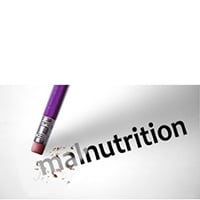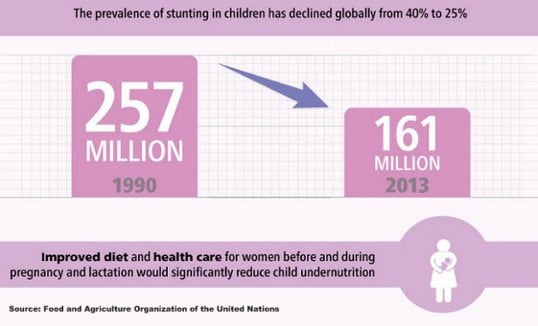-
Vulnerable populations benefit from dairy
By USDEC Staff May 28, 2015- Tweet
 Stunting affects more than 20 million newborns annually, particularly in Africa and regions of Asia. A growing body of evidence-built in part by more than five years of progressively more focused clinical and scientific research collaboratively developed between USDEC, Dairy Management Inc. and other partners internationally-supports dairy as a key part of the nutritional solution to stunting, demonstrates dairy's superiority over alternative sources of proteins, and outlines how dairy functions to prevent the condition.
Stunting affects more than 20 million newborns annually, particularly in Africa and regions of Asia. A growing body of evidence-built in part by more than five years of progressively more focused clinical and scientific research collaboratively developed between USDEC, Dairy Management Inc. and other partners internationally-supports dairy as a key part of the nutritional solution to stunting, demonstrates dairy's superiority over alternative sources of proteins, and outlines how dairy functions to prevent the condition.Organizers at the prestigious Experimental Biology Conference asked USDEC to present the latest scientific findings on the role of protein quality, growth and malnutrition and the role of dairy in food aid at this year's event in Boston on March 28-April 1. The three-hour conference-within-a-conference was called "Dairy for Global Nutrition Symposium" and brought in an international group of nutrition experts to present the latest research in the field.
Below is just of silver of the key themes presented by speakers
1) Protein quality matters.
Mark Manary, pediatrician at Washington University School of Medicine in St. Louis, Department of Pediatrics, presented groundbreaking research that establishes a strong positive correlation between protein quality scores and rates of weight gain in malnourished children.
Manary reiterated the accuracy of the Digestible Indispensable Amino Acid Score (DIAAS) rather than the old Protein Digestibility Corrected Amino Acid Score (PDCAAS) to measure protein quality. An expert U.N. Food and Agriculture Organization (FAO) consultation determined in 2012 that DIAAS was a better measure of protein quality and reaffirmed those findings in a second report released this March.
DIAAS clearly demonstrates the superiority of dairy proteins compared to plant proteins, measuring a 25-30 percent nutritional advantage over soy and pea protein.

2) The first 1,000 days of life, starting during pregnancy, are critical.
Studies show 30 percent of stunting takes place in utero. Pre-mature babies catch up in terms of growth; low-birth-weight or stunted infants cannot make up for growth and remain small and prone to an array of troubles.
David Clark, Ph.D., founder of Bovina Mountain Consulting, presented a summary of the latest research indicating that moderate dairy intake reduces risk of low birth weight. Short-term nutritional improvement during the first 1,000 days can result-in just one generation-in a gain in adult height of up to 8 cm greater than the mean parent height, noted Clark.
3) Dairy proteins promote growth, but lactose and Type II minerals in dairy-potassium, magnesium and phosphorous-also show promise at reducing the prevalence of stunting.
Benedikte Grenov, Ph.D. candidate in pediatric and internal nutrition, Department of Nutrition, Exercise and Sports at the University of Copenhagen, outlined multiple positive potential effects of lactose, including improved growth, prebiotic properties, dental benefits and the ability to foster mineral absorption.
While the picture of how dairy can help reduce levels of stunting is becoming clearer, Grenov and other speakers emphasized the need for further research. It still needs to be determined the exact dose of dairy nutrients effective at each and every stage of the first 1,000 days and how to cost optimize the treatments.
In addition, a quality statement about protein has to be developed. FAO is developing guidance documents for policy makers, the industry and the public on dietary protein quality evaluation and the use of DIAAS in making protein-related claims.

Most Popular Posts
Find by Date, Geography and Dairy Product
- September 2015 (6)
- December 2015 (5)
- September 2016 (5)
- December 2016 (5)
- June 2017 (5)
- February 2015 (4)
- March 2015 (4)
- April 2015 (4)
- May 2015 (4)
- June 2015 (4)
- July 2015 (4)
- November 2015 (4)
- January 2016 (4)
- March 2016 (4)
- June 2016 (4)
- August 2016 (4)
- October 2016 (4)
- November 2016 (4)
- February 2017 (4)
- March 2017 (4)
- April 2017 (4)
- November 2013 (3)
- October 2015 (3)
- February 2016 (3)
- April 2016 (3)
- May 2016 (3)
- July 2016 (3)
- January 2017 (3)
- May 2017 (3)
- July 2017 (3)
- August 2017 (3)
- September 2017 (3)
- October 2014 (2)
- August 2015 (2)
- October 2017 (2)
- December 2017 (2)
- July 2020 (2)
- December 2013 (1)
- February 2014 (1)
- June 2014 (1)
- August 2014 (1)
- September 2014 (1)
- November 2014 (1)
- November 2017 (1)
- January 2018 (1)
- February 2018 (1)
- May 2018 (1)
- June 2018 (1)
- July 2018 (1)
- August 2018 (1)
- September 2018 (1)
- October 2018 (1)
- November 2018 (1)
- February 2019 (1)
- March 2019 (1)
- April 2019 (1)
- July 2019 (1)
- October 2019 (1)
- March 2020 (1)
- April 2020 (1)
- June 2020 (1)
- October 2020 (1)
- November 2020 (1)
- March 2021 (1)
- April 2021 (1)
- June 2021 (1)
- August 2021 (1)
- February 2022 (1)
- June 2022 (1)
- September 2022 (1)
- October 2022 (1)
- November 2022 (1)
- February 2023 (1)
- April 2023 (1)
- USDEC Staff (65)
- Kara McDonald (24)
- Terri Rexroat (15)
- John Klees (15)
- Kristi Saitama (9)
- Angelique Hollister (8)
- Vikki Nicholson-West (8)
- Shannon Koski (8)
- Rohit Kapoor (3)
- Keith Meyer (2)
- Moises Torres-Gonzalez (2)
- Amy Foor (2)
- Alan Levitt (1)
- Tom Vilsack, President and CEO (1)
- Allison Guzman (1)
- Dacia Whitsett-Morrow (1)
- Ryan Hopkin (1)
- Matthew Pikosky (1)
- Ross Christieson (1)
- Nina Halal (1)
- Mary Wilcox (1)
Keywords
- 2018 beverage trends (3)
- 2018 Food Innovations (1)
- 2018 food trends (3)
- Asia (1)
- Avian Influenza (1)
- Award-winning cheeses (3)
- Awards (2)
- Back-to-School (1)
- Baked Goods (1)
- Bakery (1)
- Beer (2)
- Beverage (5)
- Breakfast (1)
- Butter (6)
- Casein (2)
- Cheese (48)
- cheese flavors (2)
- Cheese Pairing (3)
- Cheesemaking (5)
- Child Nutrition (3)
- China (6)
- Clean Label (6)
- Common Food Names (1)
- Consistent Supply (3)
- Consumer Insights (48)
- Consumer Promotional Tools (1)
- Consumer Trends (15)
- Contest (1)
- craft foods (2)
- Cultured dairy (1)
- Dairy (17)
- Dairy Detective (4)
- Dairy Fat (1)
- Dairy Futures and Options (3)
- Dairy Ingredients (82)
- Dairy Ingredients Symposium (1)
- Dairy Permeate (1)
- Dairy Product Solids (1)
- Dairy Production (5)
- Dairy Proteins (35)
- Dairy Resources (23)
- Dairy Trade (1)
- Dairy Trends (10)
- Dessert (1)
- Digestive Health (2)
- Donna Berry (1)
- Drinkable yogurt (1)
- Early Childhood Development (1)
- Educational Tools (1)
- Egg Replacement (2)
- Egg Substitution (1)
- Egypt (1)
- Energy (4)
- Environment (2)
- Europe (1)
- Export Data (8)
- Exports (7)
- Farming (1)
- Flavor Trends (1)
- Follow-on Formula (1)
- Food Aid (2)
- Food and Beverage Trends (7)
- Food Production (3)
- Food Technology (3)
- Foodservice (2)
- Free From Claims (1)
- Full-fat Dairy (1)
- Geographical Indications (GIs) (1)
- GHG (1)
- Global (74)
- Global Dairy Market (2)
- Global Demand (2)
- Global Market (4)
- Global Supply (1)
- Greek Yogurt (1)
- Gulfood (2)
- Gut Health (1)
- Health (1)
- Healthy Aging (8)
- Healthy Indulgence (1)
- Heavy Cream (1)
- High Quality Protein (11)
- Holiday Dessert (2)
- Holidays (1)
- IFT (7)
- IFT2016 (1)
- IFT2018 (2)
- Infant Formula (1)
- Infographic (3)
- Innova Market Insights (4)
- Innovation (2)
- Japan (7)
- Lactose (8)
- Lactose-free (1)
- LinkedIn (1)
- Malnutrition (2)
- Market Insights (67)
- Methane (1)
- Mexico (2)
- Micellar Casein (3)
- Middle East (2)
- Middle East/North Africa (9)
- Milk (8)
- Milk Permeate (2)
- Milk Powder (10)
- Milk Protein (19)
- Milkfat (5)
- Millennials (3)
- MPC (4)
- MPI (1)
- Muscle Maintenance (1)
- Muscle Recovery (2)
- Muscle Synthesis (2)
- NAFTA (1)
- New Product Introductions (1)
- New Year's Resolutions (1)
- Nonfat Dry Milk/Skim Milk Powder (4)
- Nutrition (21)
- Nutrition Research (14)
- Obesity (1)
- Overnutrition (1)
- Permeate (19)
- Price Volatility (2)
- Probiotics (2)
- Product Innovation (3)
- Protein (33)
- Prototypes (1)
- Record (3)
- Reduced-Fat (1)
- Research & Data (1)
- Resources and Tools (8)
- Risk Management (3)
- RTD Coffee and Tea (1)
- Salon Culinaire (1)
- Salt Substitute (1)
- Savory Flavors (1)
- Science and Research (3)
- Service Providers (1)
- Simple Ingredients (1)
- Singapore (1)
- Skimmed Milk Powder (2)
- Smoothies (1)
- Snack Trends (3)
- Snacking (4)
- Snacks (1)
- Sodium (3)
- Sodium Reduction (4)
- South Korea (3)
- Southeast Asia (9)
- Sports Nutrition (4)
- Stewardship (1)
- Student Competition (1)
- Supplier Directory (1)
- Supply (4)
- Sustainability (7)
- Sustainability Awards (1)
- Sustainable Nutrition (7)
- Technology (1)
- ThinkUSAdairy (2)
- Toddler Formula (1)
- Trade Data (1)
- U.S. Dairy Industry (11)
- U.S. Dairy Industry Growth (6)
- U.S. Dairy Partnerships (4)
- U.S. Dairy Products (15)
- UK (1)
- United Arab Emirates (5)
- United States (10)
- USDEC Events (44)
- Value (3)
- Vietnam (5)
- Volatility (1)
- Volume (4)
- Waste Reduction (1)
- Weight Management (6)
- Whey (14)
- Whey Ingredients (3)
- Whey Permeate (5)
- Whey Products (3)
- Whey Protein (47)
- Whey Protein Concentrate (3)
- Whey Protein Isolate (5)
- Whole-milk dairy (1)
- Wine (2)
- World Championship Cheese Contest (1)
- World Cheese Awards (2)
- World Milk Day (1)
- WPC (4)
- WPI (1)
- Yogurt (6)


